Osteoarthritis is the most common of all diseases of the musculoskeletal system. The knees are particularly vulnerable to him, because they are the ones who bear most of the load. Let's take a closer look at what osteoarthritis of the knee joint is and how to deal with this disease.
Characteristics of the disease
Osteoarthritis of the knee joints is a pathology associated with the development of degenerative-dystrophic processes in the cartilage tissue of these joints. As the disease progresses, the disease affects not only the cartilage itself, but also other tissues, including ligaments and periarticular muscles, and over time, processes can develop that contribute to the destruction ofthe bone.
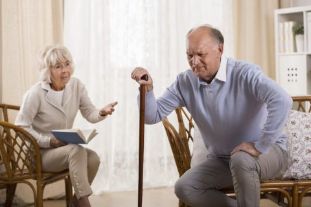
Risk groups
As we age, the body experiences difficulties leading to tissue malnutrition and accelerated wear and tear. Under the influence of mechanical, biochemical and other factors, cartilage tissue gradually begins to deteriorate, which turns into arthrosis of the right knee joint or the left joint.
With age, the frequency of diagnosis of this pathology increases. Women are especially prone to the development of knee osteoarthritis, which is due to the characteristics of their body and hormonal changes.
Athletes and people whose work is associated with lifting weights and a constant load on the legs are also at risk.
In general, the following risk groups can be distinguished:
- elderly people; athletes
- ;
- people with knee injuries;
- patients who have had surgery on the knee joint;
- sedentary;
- obese;
- associated with physical hard work or the need to be constantly on your feet;
- patients with endocrine diseases;
- people with hormonal imbalances;
- leading an unhealthy lifestyle;
- with congenital pathologies of the musculoskeletal system.
When entering a risk group, you should regularly monitor the condition of your joints, as well as take preventive measures.
Development reasons
If we talk about the specific causes of dystrophic processes in the cartilage tissue, in many ways they are associated with the daily life of a person. Existing health problems also play a role.
The main causes of knee osteoarthritis are:
- Injuries. Any damage to the knee and adjacent tissues, i. e. bruises, dislocations, tears and sprains, cracks, fractures, etc.
- Congenital disorders. This includes, for example, joint joint instability, curvature, and other developmental and functional disorders associated with structural features of the human skeleton.
- Age changes. Gradually, the cartilage tissue wears down and calcium is removed from the bones. The older a person, the more pronounced these processes.
- Obesity. Being overweight slows down metabolic processes and contributes to excessive stress on the limbs. Obese people almost always have foot problems.
- Endocrine diseases.An unhealthy state of the endocrine system leads to hormonal imbalance and metabolic disorders.
- Operational interventions. Especially strong effect is surgical manipulations on the meniscus. When removed, knee osteoarthritis develops in 90% of cases.
- Stress. Strong emotional experiences negatively affect the state of the whole organism, including elements of the musculoskeletal system.
- Tissue malnutrition. Most often these processes are associated with impaired blood circulation, since it is through the vessels of the tissue that all the necessary nutrients are supplied.
- Heavy loads.Lifting and carrying weights, improperly running and jumping, violation of the technique of physical exercises, prolonged standing - all this is an excessive load on a person's legs.
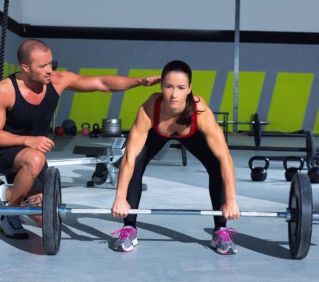
If you do not take measures to prevent the influence of these causes, the cost of such negligent treatment of your health will be represented by multiple problems with the musculoskeletal system and other bodily systems.
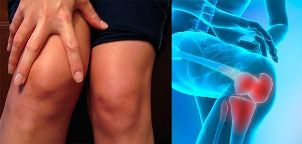
Symptoms of manifestation
At first, the disease is asymptomatic or anxiety occurs only occasionally. Most of the time, the knees start to hurt after a long time in one position or a day of hard work. Since these signs are not boring and go away completely after resting, a person does not immediately realize that he has serious health problems.
Gradually the discomfort increases, severe pain appears. They are painful in nature, but when moving they can be sharp and sharp. As the disease progresses, the discomfort increases.
Other symptoms of knee osteoarthritis are:
- deterioration of the motor capacity of the knee;
- the appearance of an audible cracking sound when moving;
- swelling and hyperemia of the tissues;
- curvature of limbs.
It is the desire to relieve pain that is most often the main stimulating factor in a person's referral to the clinic. The sooner you do this, the more likely you are to stop the disease process. Otherwise, the changes will become irreversible, and it will not be possible to solve the problem by conservative methods.
In some cases there is an increase in temperature. This phenomenon is rarely observed, it indicates an intense inflammatory process. An infection may have been the cause, for example, if you recently suffered an injury to your leg.
Types of pathology
In medical practice, the disease has a special classification.
There are the following types of knee osteoarthritis:
- Left or Right. It is localized only to one side, that is, it affects the left or right knee. Most often, this situation is observed after an injury to a limb.
- Double sided. At the same time, pathological processes develop in both legs. The symmetrical development of the disease is typical for most cases, since the internal processes of the human body have a huge influence.
- Main. It develops as an independent disease. The provoking factors are bad lifestyle, stress, age-related changes, etc.
- Secondary. Gonarthrosis becomes the consequence of another disease of the musculoskeletal system and the systems closely associated with it. Traumatic limb injuries are also included in this category.
It is also important to distinguish between periarthrosis. This disease covers the muscles and the ligamentous apparatus, thanks to which the articular joint is put in motion.
Another important category is hyperarthrosis of the knee. It is the name of the progressive degenerative processes in the cartilage. In the later stages there is a pronounced deforming knee osteoarthritis. It is worth talking in more detail about the stages of development of pathology.
Progress steps
There are four main stages of osteoarthritis of the knee. Each of them is distinguished by a more pronounced manifestation of the disease and the emergence of new negative processes.
- Step 1. Sometimes discomfort arises, but after resting and training the leg, it goes away. There is still no change in the structure of the tissues noticeable to the diagnostician, but the nutrition of the cartilage has already been disturbed, which gradually causes the progression of the pathology.
- Step 2. The pain becomes bothersome, the cartilage thins considerably, resulting in narrowing of the joint space. A characteristic crunch appears, the movements are also accompanied by unpleasant sensations.
- 3rd - 4th stage. The x-ray picture clearly shows the changes in the joint. The cartilage tissue is worn away, the bone begins to deform at the places of friction, some areas are invaded by osteophytes and salt deposits are present. All this blocks the movement of the leg and causes severe and incessant pain.
If the first degree of knee osteoarthritis is quite possible to eliminate with sparing methods and completely restore the health of the extremities, the third - fourth stages are irreversible and practically not susceptible to conservative treatment. That is why it is important to seek help from a medical facility as soon as possible.
Possible consequences and complications
Regarding the consequences of knee osteoarthritis, initially there are no particular risks to human health if appropriate measures are taken in a timely manner. Of course, inflammation of the knee causes some discomfort, but the symptoms and the dystrophic process itself can always be eliminated.
The more the patient ignores the problem, the more it is overlooked. In the second stage, the cartilage begins to deteriorate and it can hardly be restored. Severe pain disrupts a person's usual way of life, exerts psychological pressure.
The main consequences of progressive knee osteoarthritis are:
- incessant pain;
- blocking the mobility of the legs;
- the formation of bone salt growths;
- complete destruction of hyaline cartilage;
- spread of the pathological process to other regions;
- involvement of the muscular apparatus;
- handicap.
The main question: is it possible to walk with osteoarthritis of the knee? Movement contributes to the healing of the whole organism, but this rule only works if the disease is caught early.
In the later stages, movement can only aggravate the destructive process, therefore the patient is recommended to rest in bed and wear special orthotics. With the deformation and blockage of the mobility of the legs, walking is impaired, that is, a person becomes disabled. This is the main risk of developing knee osteoarthritis.
Diagnostic rules
In order to avoid such complications and not become disabled, you should promptly seek help. An orthopedic surgeon can advise you on the treatment of knee osteoarthritis.
The success of further treatment largely depends on the degree of detail of the diagnosis, and therefore it is not necessary to ignore a specialist's prescriptions regarding the need for certain examination procedures.
The complete diagnosis of osteoarthritis may include the following methods:
- Laboratory blood tests. Necessary to identify deviations from the norm in terms of benchmarks. The presence of violations indicates an inflammatory process or other problems that can directly or indirectly indicate joint diseases. A rheumatic test can be done separately, if there is such a need. It is also important to assess the level of glucose in the blood, since its increase may indicate problems with the endocrine system, which also affects the state of the musculoskeletal system and metabolic processes in the body.
- Radiography. This is a mandatory procedure that allows you to take into account the condition of the diseased area. The image shows the bony areas. The degree of wear of the cartilage is evaluated by the size of the joint space, the position of individual joint elements, the presence of foreign formations and other indicators. Ultrasound
- . Ultrasound waves allow a more detailed examination of the condition of the soft tissues themselves, including the cartilage. Ultrasound detects inflammatory processes, detects solid inclusions, as well as tumor formations.
- MRI. Magnetic resonance imaging is the best method to examine the condition of the joints. The image clearly shows all parts of the joint and adjacent soft tissues, as well as the blood vessels. The image contains a layer-by-layer structure and the process itself takes place dynamically, so that the doctor can see everything he needs to make a diagnosis. If MRI is contraindicated, computed tomography can be used as an alternative.
- Arthroscopy. A more detailed study of the knee is possible by inserting an arthroscope into its cavity. The procedure is less traumatic, so it can be done without fear for your health. The camera clearly shows the condition of the cartilage and other tissues.
Processing methods
In order to get rid of knee osteoarthritis and its consequences, it is necessary to properly approach the solution of this problem. Only the attending physician can choose the most effective remedy in each case.
Most often a variety of drugs are used, as well as traditional methods. Some of the techniques overlap closely, eg various compresses.
If done correctly, it will be possible to significantly weaken the manifestations of the disease and restore the health of your legs to a certain extent. In any case, he should not hesitate with the treatment, otherwise it will not be possible to do without drastic measures.
Drug treatment
The first thing to start treatment with is drug therapy. It can be broken down into several areas, depending on the goals you plan to achieve:
- Pain relief. With osteoarthritis, it is the need for pain relief that causes most patients to seek specialist help for a list of medications. Pain relievers are needed for severe discomfort, for example, injections are given in the third stage of knee osteoarthritis.
- Elimination of inflammation. Since pain in osteoarthritis of the knee joint can be relieved by stopping the inflammatory process, nonsteroidal anti-inflammatory drugs are prescribed without fail.
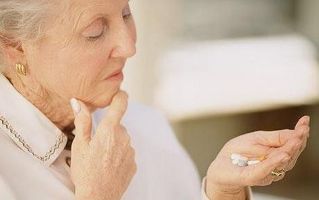 If the situation is neglected, brief courses of glucocorticoids may be prescribed to enhance the effect.
If the situation is neglected, brief courses of glucocorticoids may be prescribed to enhance the effect. - Restoration of cartilage. It is necessary to stimulate the regeneration of hyaline cartilage and improve its nutrition, as well as to protect it from future destruction. For this, different groups of chondroprotectors are used. If we consider the question of whether the drug helps to treat osteoarthritis of the knee joint, then pay attention to the composition of the drug. The combination of important ingredients is one of the most effective products in this category.
- Improved tissue nutrition. To speed up recovery processes and strengthen the joint joint, various drugs and additives are prescribed to improve metabolism, stimulate blood circulation, and saturate cells with vitamins and minerals.
Only the attending physician has the right to prescribe and correct drug treatment for osteoarthritis of the knee. Independent use of drugs is undesirable, only the use of vitamin supplements and the use of certain chondroprotectors are allowed.

Diet and lifestyle
An important step in the treatment process is to change your lifestyle, especially your eating habits. It all depends on the severity of the disease, for example, cycling in the early stages of development can be beneficial and stimulate recovery processes.
At the same time, when problems with flexion-extension movements appear, such a load can only worsen the patient's condition and aggravate destructive processes.
In general, activity is encouraged, as movement helps in the treatment of many diseases of the musculoskeletal system. In this case, it is extremely important to observe the rest regime, not to overload the legs and to avoid sudden movements.
In particular, whether it is possible to run with osteoarthritis of the knee joint is under investigation. It is best to replace this type of physical activity with a brisk walk.
If we talk about nutrition, the contraindications for knee osteoarthritis are the consumption of alcohol and junk food. It is especially important to exclude fatty and salty foods.
The diet should be as healthy as possible, that is, include vegetables and fruits, whole grains, milk and cheese, lean meat and fish. Products that help restore hyaline cartilage are very useful: seafood, organ meats, jellies, apples, seaweed, etc.
Physiotherapy and other procedures
Physiotherapy is a mandatory component of treatment. In addition, modern medicine actively uses a variety of manual and non-traditional methods to influence the body. It is recommended to pay attention to these procedures.
- Magnetotherapy. It is one of the techniques of physiotherapy. The magnetic effect stimulates the recovery processes, improves the effect of drugs. Electrophonophoresis can also be used as an alternative. Massage
- . Various types of manual influences should be performed by a qualified specialist based on the results of the diagnosis and the instructions of the attending physician. Massage stimulates metabolic processes in the tissues, improves mobility of the legs, relieves discomfort.
- Hirudotherapy. This is a leech treatment. Leeches are known for their safe blood purification. They bite the patient's skin, substances that prevent blood from clotting come with the saliva. Minor bleeding of this type helps to eliminate the inflammatory process, improve tissue nutrition and have an effect on the general health of the body.
- Acupuncture. This is one of the methods of reflexology, the essence of which is to influence the active points located not only in the diseased area, but also throughout the body. The doctor inserts special needles into the skin exactly at the places that should be used to solve the problem of knee osteoarthritis.
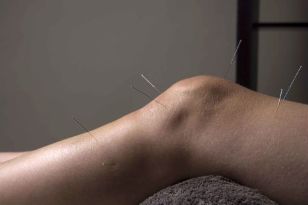
Catching up gymnastics
If we take a closer look at the treatment with the help of physical exercises, first of all it should be noted that the norms of permissible loads are established by a specialist. It is best to attend group exercise therapy classes. Sport for osteoarthritis of the knee is included in the compulsory program, including during rehabilitation after surgery.

Let us underline the main directions used for knee osteoarthritis:
- Swimming pool. Swimming relieves stress and tension on the legs and gently helps develop the problem area. In particular, water aerobics is useful for osteoarthritis of the knee joint, especially for overweight people and elderly patients.
- Hiking. There is no doubt whether walking is useful for knee osteoarthritis, but at the same time, walks should be short and regular. But running is not recommended as a method of treatment.
- Training with simulators. It can be special training blocks or, for example, an exercise bike, if you have no contraindications. They are useful for strengthening the muscular and ligamentous apparatus.
- Catch-up gymnastics. Orthopedists and professional rehabilitation therapists develop special sets of exercises that help to gently train all groups of joints and restore their health.
Physical activity for osteoarthritis of the knee joint should be regular and strictly dosed. If you overload your legs or skip classes, there will be no beneficial effect. It is also important to choose the right exercises for your specific situation. Check this point in advance with the curator, for example, is it possible to squat with osteoarthritis in your case.
Traditional medicine
In addition, the treatment of osteoarthritis of the knee joint at home is closely related to the use of traditional medicine recipes. It should be remembered that before using this or that remedy prepared yourself, you should make sure that there are no allergies and other contraindications, and also consult your doctor.
Otherwise, the effect may be reversed or the effect of home remedies may over-increase the effect of pharmacy drugs. Nevertheless, traditional methods are still in demand, as their price is much lower than most drugs purchased.
For knee osteoarthritis, the following remedies are most often used:
- Herbal teas. Infusions and decoctions of bay leaves, chamomile, St. John's wort, yarrow and other medicinal plants are actively used for external and internal use. They are able to relieve inflammation, relieve pain, remove salts, and nourish the body with vitamins and other useful substances.
- Beekeeping products. Propolis, perga, bee plague, wax and honey have an omnidirectional healing effect. That is why treating osteoarthritis of the knee joint with honey is such a popular direction. However, it should be remembered that bee products can cause serious allergies, so first make sure that they are safe to use.
- Alcohol tinctures. It is an excellent remedy for warming and stimulating blood circulation, relieving inflammation, and improving mobility of the legs. For joints, white lilacs are especially useful, which need to be cleaned from greens and poured with vodka for two weeks. Also, the infusion is used to rub the affected area.
- Fresh plants. You can also use rough gifts from nature. For example, a leaf of burdock or white cabbage should be lightly kneaded and then tied to the knee for at least 10 hours. You can use prefabricated compresses, for example, add medical bile, unrefined sunflower oil, honey, etc.
- Animal fats. They are added to homemade creams. To create an optimal consistency, the fat should be mixed with beeswax, herbal decoctions and other components can be added.
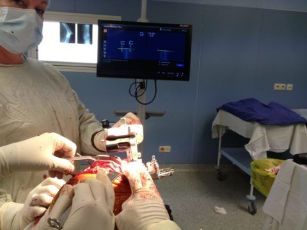
Surgical intervention and rehabilitation
Most patients worry about the question: Is osteoarthritis of the knee joint curable if it has already passed to 2nd - 3rd stage? Unfortunately, it will not be possible to restore the health of the cartilaginous lining, but there is still a way out of the situation.
If you have advanced osteoarthritis of the knee joint, treatment options are divided into surgery and conservative ancillary techniques. If the cartilage is completely worn away, only by performing an operation can the functions of the damaged limb be restored.
The best option is to use stents. In this case, the damaged elements of the joint joint are partially or completely removed, and special prostheses are installed in their place with the help of bolts and surgical cement. Over time, they will become overgrown with bone tissue and completely take on all the necessary load.
Since it is not always possible to treat osteoarthritis of the knee joints in this way, the arthrodesis method is used as an alternative to reduce pain and avoid further deformity of the limb.
If in the first case the motor capacity of the leg is restored to the maximum, with arthrodesis the opposite effect appears - the limb is fixed in a certain position, and after the incision of the bone, the elements are merged. Thus, the movement will only be available in one direction.
Disease prevention
In order to prevent the development of the disease, it is believed to prevent osteoarthritis of the knee joint.
To do this, follow these instructions:
- avoid injury;
- do not overload your knees;
- be less nervous;
- lead an active life;
- give up bad habits;
- eat well;
- keep track of your weight;
- Treat other illnesses in a timely manner.
At the first concern, consult your doctor in order to start fighting the disease in time.

























